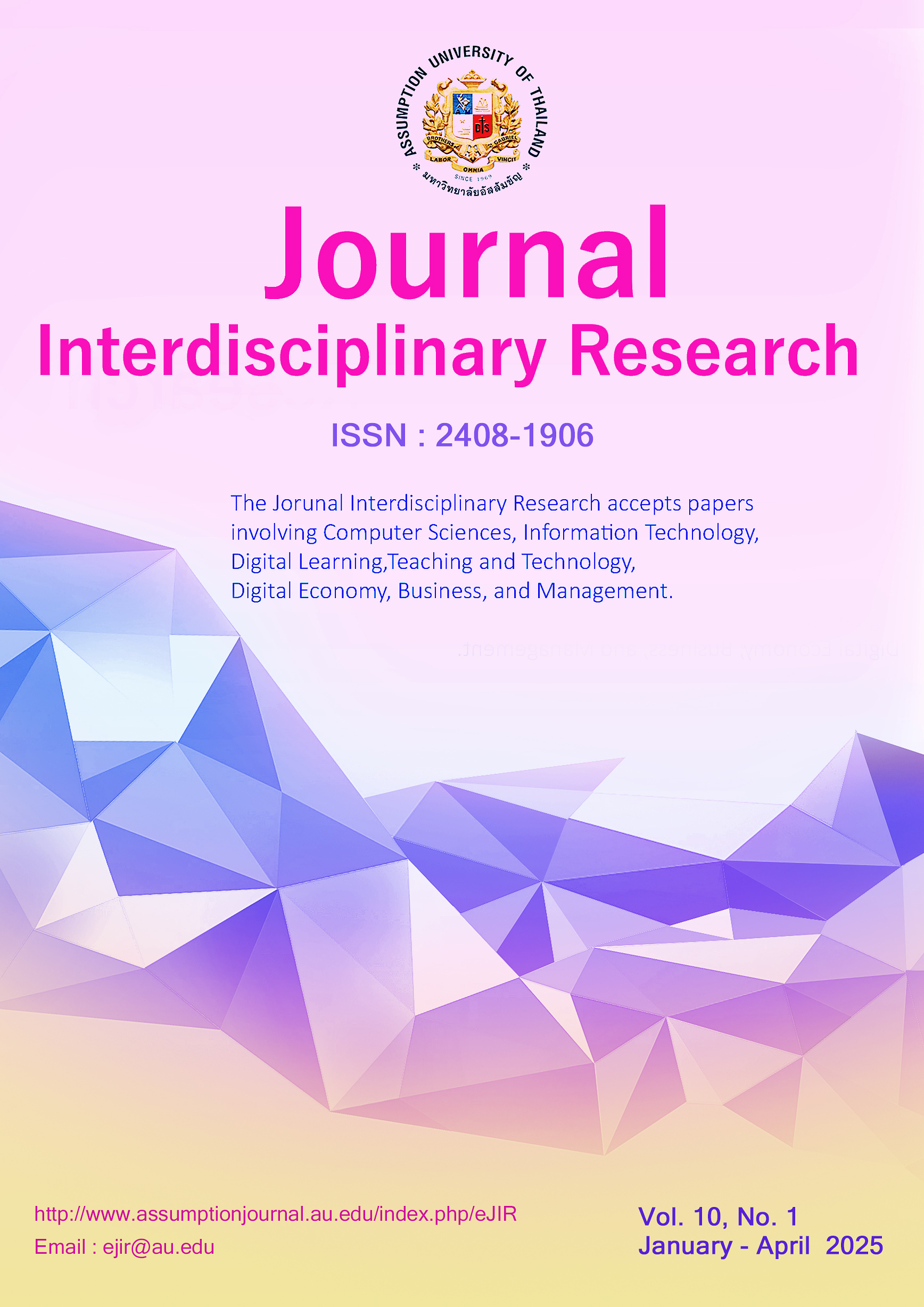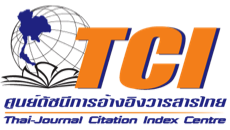Enhancing Entrepreneurial Intentions through Self-Efficacy: A Study of Art Students in Hubei, China
DOI:
https://doi.org/10.14456/au-ejir.2025.4Keywords:
Entrepreneurial Intentions, Self-efficacy, Educational Interventions, Strategical Plan, Art StudentsAbstract
Purpose: This study explores the influence of five variables—entrepreneurial education, self-efficacy, personal attitude, social norms, and perceived behavioral control on the entrepreneurial intentions of art students at a university in Hubei, China. The focus is particularly on identifying which factors significantly affect these intentions. Research design, data and methodology: Employing a mixed-method approach, the research collected data from 60 students using quantitative surveys and qualitative interviews. Multiple linear regression analysis was utilized to determine the impact of each variable on entrepreneurial intentions. All participants were involved in a 14-week strategic intervention program, with data from pre- and post-intervention analyzed through paired-sample t-tests. Results: The regression analysis confirmed that self-efficacy (H2) had a significant and positive impact on students’ entrepreneurial intentions, highlighting its pivotal role compared to the other variables tested. This research underscores the importance of enhancing self-efficacy to foster entrepreneurial intentions among students. Conclusions: Educational institutions can leverage these insights to design interventions that effectively cultivate an entrepreneurial mindset, especially focusing on boosting self-efficacy among students in creative fields.
References
Ajzen, I. (1991). The theory of planned behavior. Organizational Behavior and Human Decision Processes, 50(2), 179-211. https://doi.org/10.1016/0749-5978(91)90020-T
Amundsen, S., & Martinsen, Ø. L. (2015). Linking empowering leadership to job satisfaction, work effort, and creativity: The role of self-leadership and psychological empowerment. Journal of Leadership & Organizational Studies, 22(3), 304-323. https://doi.org/10.1177/1548051814565819
Bandura, A. (1986). Social foundations of thought and action: A social cognitive theory. Prentice-Hall.
Barba-Sánchez, V., & Atienza-Sahuquillo, C. (2018). Entrepreneurial intention among engineering students: The role of entrepreneurship education. European Research on Management and Business Economics, 24(1), 53-61. https://doi.org/10.1016/j.iedeen.2017.04.001
Bayron, C. E. (2013). Social cognitive theory, entrepreneurial self-efficacy and entrepreneurial intentions: Tools to maximize the effectiveness of formal entrepreneurship education and address the decline in entrepreneurial activity, Griot, 6(1), 66-77.
Brown, T. E., Davidsson, P., & Wiklund, J. (2023). Creative industries and entrepreneurship: Overcoming the business confidence gap. Journal of Business Venturing Insights, 19, e00337. https://doi.org/10.1016/j.jbvi.2023.00337
Charney, A., & Libecap, G. D. (2000). The impact of entrepreneurship education: An evaluation of the Berger Entrepreneurship Program at the University of Arizona, 1985-1999. University of Arizona. https://doi.org/10.2139/ssrn.1262343
Cialdini, R. B., Reno, R. R., & Kallgren, C. A. (1990). A focus theory of normative conduct: Recycling the concept of norms to reduce littering in public places. Journal of Personality and Social Psychology, 58(6), 1015-1026.
https://doi.org/10.1037/0022-3514.58.6.1015
Dickson, P. H., Solomon, G. T., & Weaver, K. M. (2008). Entrepreneurial selection and success: Does education matter? Journal of Small Business and Enterprise Development, 15(2), 239-258. https://doi.org/10.1108/14626000810871655
Duong, C. D., & Le, T. L. (2021). ADHD symptoms and entrepreneurial intention among Vietnamese college students: An empirical study. Journal of Entrepreneurship in Emerging Economies, 14(3), 495-522. https://doi.org/10.1108/JEEE-02-2021-0049
Elia, G., Margherita, A., & Passiante, G. (2023). Exploring the role of digitalization in creative entrepreneurship: A systematic literature review. Technological Forecasting and Social Change, 191, 122453. https://doi.org/10.1016/j.techfore.2023.122453
Fang, S., Chen, H., & Liu, Y. (2023). The dual role of self-efficacy in creative entrepreneurship: Bridging creative confidence and business readiness. Creativity and Innovation Management, 32(2), 1-14. https://doi.org/10.1111/caim.12567
Gangi, Y. (2023). The paradox of the creative entrepreneur: Artistic passion vs. business competence. Small Business Economics, 60(1), 113-130. https://doi.org/10.1007/s11187-023-00785-2
Gorman, G., Hanlon, D., & King, W. (1997). Some research perspectives on entrepreneurship education, enterprise education, and education for small business management: A ten-year review. International Small Business Journal, 15(3), 56-77.
Gul, S., Anjum, M. N., & Bajwa, M. A. (2023). Role of perceived behavioral control, perceived trust, and entrepreneurial intentions in crowdfunding intentions. Contemporary Issues in Social Sciences and Management Practices, 2(4), 340-354. https://doi.org/10.61503/cissmp.v2i4.107
Hair, J. F., Anderson, R. E., Tatham, R. L., & Black, W. C. (1995). Multivariate data analysis. Prentice-Hall.
Hasani, V., Zeqiri, J., Gagica, K., Gleason, K., & Ibraimi, S. (2023). Education and enterprising profile of young community: Evidence from a transition country. Journal of Enterprising Communities: People and Places in the Global Economy, 17(2), 519-534. https://doi.org/10.1108/JEC-11-2021-0153
Hindle, K., & Moroz, P. W. (2009). Indigenous entrepreneurship as a research field: Developing a definitional framework from the emerging canon. International Entrepreneurship and Management Journal, 6(4), 357-385.
https://doi.org/10.1007/s11365-009-0111-x
Hu, W., Hu, Y., Lyu, Y., & Chen, Y. (2021). Research on integrated innovation design education for cultivating the innovative and entrepreneurial ability of industrial design professionals. Frontiers in Psychology, 12, 1-12.
https://doi.org/10.3389/fpsyg.2021.693216
Jing, S., Zhai, Q., & Landström, H. (2015). Entrepreneurship research in three regions—the USA, Europe, and China. International Entrepreneurship and Management Journal, 11(4), 861-890. https://doi.org/10.1007/s11365-014-0315-6
Katz, J. A. (2008). Fully mature but not fully legitimate: A different perspective on the state of entrepreneurship education. Journal of Small Business Management, 46(4), 550-566. https://doi.org/10.1111/j.1540-627x.2008.00256.x
Kautonen, T., Van Gelderen, M., & Fink, M. (2015). Robustness of the theory of planned behavior in predicting entrepreneurial intentions and actions, Entrepreneurship Theory and Practice, 39(3), 655-674. https://doi.org/10.1111/etap.12056
Kraus, S., Clauss, T., Breier, M., Gast, J., Zardini, A., & Tiberius, V. (2022). Business model innovation in creative industries: Insights from start-ups in fashion, music, and design. Journal of Business Research, 146, 376-386.
https://doi.org/10.1016/j.jbusres.2022.03.021
Krueger, N. F., & Brazeal, D. V. (1994). Entrepreneurial potential and potential entrepreneurs. Entrepreneurship Theory and Practice, 18(3), 91-104.
Krueger, N. F., & Carsrud, A. L. (1993). Entrepreneurial intentions: Applying the theory of planned behavior. Entrepreneurship & Regional Development, 5(4), 315-330. https://doi.org/10.1080/08985629300000020
Kurbanoğlu, S. S. (2004). Öz-yeterlik inancı ve bilgi profesyonelleri için önemi. Bilgi Dünyası, 5(2), 137-152.
https://doi.org/10.15612/bd.2004.484
Liñán, F., & Chen, Y. W. (2009). Development and cross‐cultural application of a specific instrument to measure entrepreneurial intentions. Entrepreneurship Theory and Practice, 33(3), 593-617. https://doi.org/10.1111/j.1540-6520.2009.00318.x
Lukas, J. W., Haddock, G., & Maio, G. R. (2020). Attitudes. Oxford Research Encyclopedia of Psychology.
https://doi.org/10.1093/acrefore/9780190236557.013.247
Manimala, M. J., & Thomas, P. (2017). Entrepreneurship education: Innovations and best practices. Springer.
https://doi.org/10.1007/978-981-10-3319-3_1
Naznen, F., Al Mamun, A., & Rahman, M. K. (2023). Modelling social entrepreneurial intention among university students in Bangladesh using value-belief-norm framework. Current Psychology, 42(11), 31110-31127. https://doi.org/10.1007/s12144-022-04119-2
Newman, A., Obschonka, M., Schwarz, S., Cohen, M., & Nielsen, I. (2019). Entrepreneurial self-efficacy: A systematic review of the literature on its theoretical foundations, measurement, antecedents, and outcomes. Journal of Vocational Behavior, 110, 403-419. https://doi.org/10.1016/j.jvb.2018.05.012
Nowiński, W., Haddoud, M. Y., Lančarič, D., Egerová, D., & Czeglédi, C. (2019). The impact of entrepreneurship education, entrepreneurial self-efficacy and gender on entrepreneurial intentions of university students in the Visegrad countries. Studies in Higher Education, 44(2), 361-379. https://doi.org/10.1080/03075079.2017.1365359
Nunnally, J. C., & Bernstein, I. H. (1994). The assessment of reliability (3rd ed.). McGraw-Hill.
Oyugi, L. O. (2015). Self-efficacy and entrepreneurial intentions among university students in Kenya. African Journal of Business Management, 9(17), 634-641.
Paliwal, M., Rajak, B. K., Kumar, V., & Singh, S. (2022). Assessing the role of creativity and motivation to measure entrepreneurial education and entrepreneurial intention. International Journal of Educational Management, 36(5), 854-874. https://doi.org/10.1108/IJEM-05-2021-0178
Peterman, N. E., & Kennedy, J. (2003). Enterprise education: Influencing students’ perceptions of entrepreneurship. Entrepreneurship Theory and Practice, 28(2), 129-144.
Pittaway, L., & Cope, J. (2007). Entrepreneurship education: A systematic review of the evidence. International Small Business Journal, 25(5), 479-510.
Plaschka, G. R., & Welsch, H. P. (1990). Emerging structures in entrepreneurship education: Curricular designs and strategies. Entrepreneurship Theory and Practice, 14(3), 55-71.
Potishuk, V., & Kratzer, J. (2017). Factors affecting entrepreneurial intentions and entrepreneurial attitudes in higher education. Journal of Entrepreneurship Education, 20(1), 25-44.
Ramadani, V., Hisrich, R. D., & Abazi-Alili, H. (2022). Teaching entrepreneurship in creative industries: The missing link between artistic skills and business acumen. Education + Training, 64(2), 103-119. https://doi.org/10.1108/ET-03-2021-0097
Schlesinger, L. A., Kiefer, C. F., & Brown, P. B. (2022). Creative entrepreneurs: How the arts drive innovation and business growth. Harvard Business Review, 100(4), 67-75.
Shi, L., & Wang, J. (2023). The role of family support and social norms in shaping entrepreneurial intention: Evidence from China. Journal of Entrepreneurship in Emerging Economies, 15(3), 412-430. https://doi.org/10.1108/JEEE-06-2022-0179
Shi, X., Lafuente, E., & Liu, H. (2020). Enhancing entrepreneurial self-efficacy and business skills through university-based entrepreneurship education. International Journal of Entrepreneurial Behavior & Research, 26(5), 953-976.
https://doi.org/10.1108/IJEBR-12-2019-0720
Shirokova, G., Bogatyreva, K., & Beliaeva, T. (2022). The effect of entrepreneurship education on students’ attitudes toward innovation and business creation. Technovation, 119, 102538. https://doi.org/10.1016/j.technovation.2022.102538
Wilson, F., Kickul, J., & Marlino, D. (2007). Gender, entrepreneurial self-efficacy, and entrepreneurial career intentions: Implications for entrepreneurship education. Entrepreneurship Theory and Practice, 31(3), 387-406.
https://doi.org/10.1111/j.1540-6520.2007.00179.x
Zhao, H., Li, S., Hui, X., Ye, L., & Chen, M. (2022). The influence of educational psychology on modern art design entrepreneurship education in colleges. Frontiers in Psychology, 13, 1-11. https://doi.org/10.3389/fpsyg.2022.843484
Downloads
Published
How to Cite
Issue
Section
License
Copyright (c) 2025 Zhang Qin

This work is licensed under a Creative Commons Attribution 4.0 International License.
A separate Copyright Form will be sent to authors whose paper is accepted for publication.






